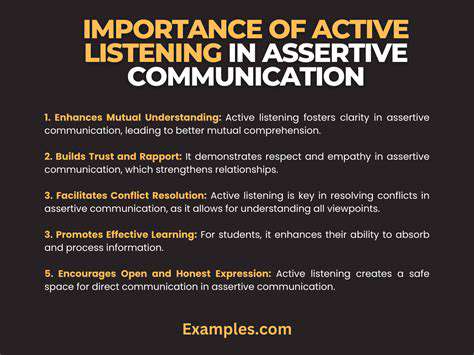Understanding Your Communication Preferences
Recognizing how you communicate is the foundation for developing stronger, more assertive interactions. Your natural tendencies—whether you're more reserved or outspoken, accommodating or forceful—shape every conversation you have. By examining these patterns, you gain the power to consciously adjust your approach rather than falling into habitual responses. Think back to recent discussions: what words do you typically choose? How do you physically present yourself when speaking?
Notice the subtle details in your speech patterns. Do you frequently soften statements with phrases like I feel or perhaps, even when certain? Alternatively, might your word choices sometimes come across as overly blunt? Pay equal attention to nonverbal signals - your posture, eye contact, and vocal volume all communicate volumes. These observations create a mirror showing your current communication habits and highlighting opportunities for refinement.
Applying Insights to Assertive Communication
With this self-knowledge, you're positioned to cultivate truly effective communication. Assertiveness isn't about dominance or passivity—it's the art of expressing yourself clearly while respecting others. This balanced approach leads to more meaningful exchanges in all areas of life, from workplace collaborations to personal relationships.
Your communication assessment reveals potential obstacles to being heard. Do you often hold back important thoughts? Feel frequently misunderstood? Recognizing these patterns marks the starting point for positive change. With focused attention on your communication habits, you can progressively adopt more effective strategies that improve how you connect with others.
Examine your responses in challenging situations. Are you consistently prioritizing others' needs over your own? Or finding it difficult to balance both? Identifying these tendencies provides crucial understanding of how your communication style functions in real interactions. Developing assertiveness is an evolving practice—one that begins with honest self-assessment.
This reflective process illuminates pathways for growth. Those inclined toward passivity can practice clearer self-expression, while naturally forceful communicators might focus on tempering their delivery. Wherever you begin, understanding your current communication style forms the essential first step toward more effective interactions.

Managing Difficult Interactions with Healthcare Professionals

Understanding the Root Causes
Successful navigation of challenging professional interactions begins with identifying their underlying causes. These often stem from unconscious biases, communication mismatches, or unaddressed concerns. Maintaining objectivity when analyzing conflicts—separating facts from emotional reactions—reveals the true nature of the disagreement. This measured approach leads to more constructive resolutions.
Equally important is appreciating differing viewpoints. While you may not agree with another's perspective, understanding their position creates common ground for improved dialogue. This requires genuine listening and a willingness to comprehend alternative viewpoints.
Active and Empathetic Listening
Truly effective listening forms the cornerstone of resolving professional tensions. It demands full engagement—processing both spoken words and unspoken signals. Practice reflecting back key points to confirm understanding, while demonstrating sincere interest in the speaker's concerns.
Establishing Clear Communication Channels
Well-defined communication protocols prevent misunderstandings before they arise. Implementing structured methods for feedback and conflict management creates a framework for productive exchanges. This forward-thinking strategy establishes transparent expectations, transforming potential conflicts into opportunities for mutual understanding.
Developing Conflict Resolution Strategies
Effective conflict management requires preparation and practice. Familiarize yourself with various resolution approaches, selecting the most appropriate for each situation. Having predetermined communication tactics provides confidence when navigating professional challenges.
Your strategy toolkit should include techniques for reducing tension, collaborative problem-solving, and finding mutually beneficial solutions. Regular practice of these methods enhances your ability to handle difficult exchanges with professionalism.
Maintaining Professional Boundaries
Preserving appropriate professional limits is essential during tense interactions. Keep discussions focused on substantive issues rather than personal matters. Adhering to professional standards—even in challenging moments—ensures conflicts remain productive rather than personal.
Seeking Support and Feedback
Don't underestimate the value of external perspectives. Colleagues, mentors, or human resources professionals can offer invaluable insights into your conflict management approach. This support network provides objective assessments that help refine your professional communication skills over time.